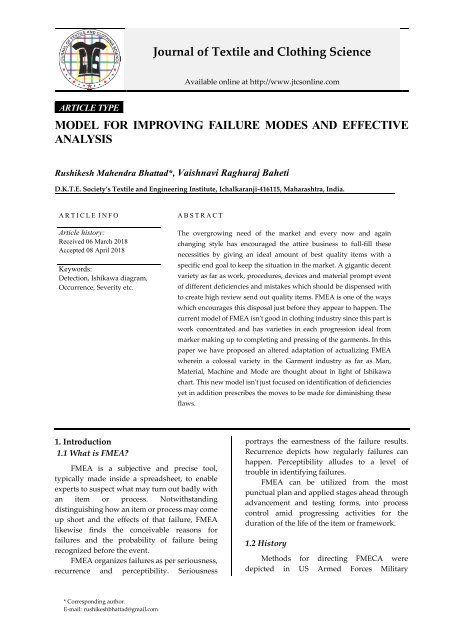JTCS Volume 1 Issue 1
The Journal of Textile and Clothing Science (JTCS) is a peer-reviewed (refereed) journal. Which is aimed at providing the platform to exchange information pertaining to all sectors of textile and the clothing industry among researchers, textile technocrats, fashion designers and industry experts. The journal focuses on scientific, technical, economical, managerial and all other aspects of textile activity at theoretical and experimental level. JTCS is aimed at publishing original research articles, review papers, short communications, and letters to the editor and book reviews catering the needs of both industry and academia.
The Journal of Textile and Clothing Science (JTCS) is a peer-reviewed (refereed) journal. Which is aimed at providing the platform to exchange information pertaining to all sectors of textile and the clothing industry among researchers, textile technocrats, fashion designers and industry experts.
The journal focuses on scientific, technical, economical, managerial and all other aspects of textile activity at theoretical and experimental level. JTCS is aimed at publishing original research articles, review papers, short communications, and letters to the editor and book reviews catering the needs of both industry and academia.
Create successful ePaper yourself
Turn your PDF publications into a flip-book with our unique Google optimized e-Paper software.
Journal of Textile and Clothing Science<br />
Available online at http://www.jtcsonline.com<br />
ARTICLE TYPE<br />
MODEL FOR IMPROVING FAILURE MODES AND EFFECTIVE<br />
ANALYSIS<br />
Rushikesh Mahendra Bhattad*, Vaishnavi Raghuraj Baheti<br />
D.K.T.E. Society’s Textile and Engineering Institute, Ichalkaranji-416115, Maharashtra, India.<br />
A R T I C L E I N F O<br />
Article history:<br />
Received 06 March 2018<br />
Accepted 08 April 2018<br />
Keywords:<br />
Detection, Ishikawa diagram,<br />
Occurrence, Severity etc.<br />
A B S T R A C T<br />
The overgrowing need of the market and every now and again<br />
changing style has encouraged the attire business to full-fill these<br />
necessities by giving an ideal amount of best quality items with a<br />
specific end goal to keep the situation in the market. A gigantic decent<br />
variety as far as work, procedures, devices and material prompt event<br />
of different deficiencies and mistakes which should be dispensed with<br />
to create high review send out quality items. FMEA is one of the ways<br />
which encourages this disposal just before they appear to happen. The<br />
current model of FMEA isn't good in clothing industry since this part is<br />
work concentrated and has varieties in each progression ideal from<br />
marker making up to completing and pressing of the garments. In this<br />
paper we have proposed an altered adaptation of actualizing FMEA<br />
wherein a colossal variety in the Garment industry as far as Man,<br />
Material, Machine and Mode are thought about in light of Ishikawa<br />
chart. This new model isn't just focused on identification of deficiencies<br />
yet in addition prescribes the moves to be made for diminishing these<br />
flaws.<br />
1. Introduction<br />
1.1 What is FMEA?<br />
FMEA is a subjective and precise tool,<br />
typically made inside a spreadsheet, to enable<br />
experts to suspect what may turn out badly with<br />
an item or process. Notwithstanding<br />
distinguishing how an item or process may come<br />
up short and the effects of that failure, FMEA<br />
likewise finds the conceivable reasons for<br />
failures and the probability of failure being<br />
recognized before the event.<br />
FMEA organizes failures as per seriousness,<br />
recurrence and perceptibility. Seriousness<br />
portrays the earnestness of the failure results.<br />
Recurrence depicts how regularly failures can<br />
happen. Perceptibility alludes to a level of<br />
trouble in identifying failures.<br />
FMEA can be utilized from the most<br />
punctual plan and applied stages ahead through<br />
advancement and testing forms, into process<br />
control amid progressing activities for the<br />
duration of the life of the item or framework.<br />
1.2 History<br />
Methods for directing FMECA were<br />
depicted in US Armed Forces Military<br />
* Corresponding author.<br />
E-mail: rushikeshbhattad@gmail.com



